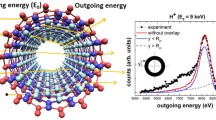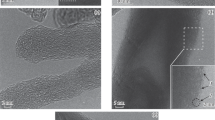Abstract
Carbon nanotube properties can be modified by ion irradiation; therefore it is important to know the manner in which ions deposit energy (how much and where) in the nanotubes. In this work, we have studied, experimentally and with a simulation code, the irradiation of multi-walled carbon nanotubes (MWCNT), supported on a holey amorphous carbon (a-C) substrate, with low energy (2–10 keV/u) H+ and H2+ molecular beams, impinging perpendicularly to the MWCNT axis. The energy distribution of protons traversing the nanotubes (either from the H+ beam or dissociated from the H2+ beam) was measured by the transmission technique in the forward direction. Two well-differentiated peaks appear in the experimental energy-loss distribution of the fragments dissociated from the molecular H2+ beam, in correspondence to the ones detected with the proton beam. One is the low-energy loss peak (LELP), which has a symmetric width; the other is the high-energy loss peak (HELP), which shows an asymmetric broadening towards larger energy loss than the corresponding proton energy distribution. A semi-classical simulation, accounting for the main interaction processes (both elastic and inelastic), of the proton trajectories through the nanotube and the supporting substrate has been done, in order to elucidate the origin of these structures in the energy spectra. Regarding the H+ energy spectrum, the LELP corresponds to projectiles that travel in quasi-channelling motion through the most outer walls of the nanotubes and then pass through the substrate holes, whereas the HELP results mostly from projectiles traversing only the a-C substrate, with the asymmetry broadening being due to a minor contribution of those protons that cross the a-C substrate after exiting the nanotube. The broadening of the peaks corresponding to dissociated fragments, with respect to that of the isolated protons, is the result of vicinage effects between the fragments, when travelling in quasi-channelling conditions through the outer layers of the nanotube, and Coulomb explosion just after exiting the target. The excellent agreement between the measured and the simulated energy spectra of the H+ beam validates our simulation code in order to predict the energy deposited by ion beams in carbon nanotubes.
Graphical abstract

Similar content being viewed by others
References
S.M. Shubeita, P.L. Grande, J.F. Dias, R. Garcia-Molina, C.D. Denton, I. Abril, Phys. Rev. B 83, 245423 (2011)
N.E. Koval, A.G. Borisov, L.F.S. Rosa, E.M. Stori, J.F. Dias, P.L. Grande, D. Sánchez-Portal, R. Dez Muiño, Phys. Rev. A 95, 062707 (2017)
J.E. Valdés, C. Parra, J. Daz-Valdés, C.D. Denton, C. Agurto, F. Ortega, N.R. Arista, P. Vargas, Phys. Rev. A 68, 064901 (2003)
R.H. Baughman, A.A. Zakhidov, W.A. de Heer, Science 297, 787 (2002)
M.S. Dresselhaus, G. Dresselhaus, P. Avouris, Carbon Nanotubes, Synthesis, Structure, Properties and Applications (Springer, Berlin, 2001)
A.V. Krasheninnikov, K. Nordlund, J. Appl. Phys. 107, 071301 (2010)
A. Olejniczak, V.A. Skuratov, Nucl. Instrum. Methods Phys. Res. B 326, 33 (2014)
Y. Zhang, L. Chen, Z. Xu, Y. Li, M. Shan, L. Liu, Q. Guo, G. Chen, Z. Wang, C. Wang, Int. J. Mat. Prod. Technol. 45, 1 (2012)
Z.L. Mišković, Radiat. Eff. Defects Solids 162, 185 (2007)
J.E. Valdés, C. Celedón, R. Segura, I. Abril, R. Garcia-Molina, C.D. Denton, N.R. Arista, P. Vargas, Carbon 52, 137 (2013)
C.E. Celedón, A. Cortés, E.A. Sánchez, M.S. Moreno, J.D. Uribe, N.R. Arista, J.E. Valdés, Eur. Phys. J. D 71, 64 (2017)
R.A. Segura, A. Tello, G. Cárdenas, P. Häberle, Phys. Status Solidi A 204, 513 (2007)
I. Kyriakou, C. Celedón, R. Segura, D. Emfietzoglou, P. Vargas, J.E. Valdés, I. Abril, C.D. Denton, K. Kostarelos, R. Garcia-Molina, Nucl. Instrum. Methods Phys. Res. B 268, 1781 (2010)
R.A. Segura, S. Hevia, P. Häberle, J. Nanosci. Nanotechnol. 11, 10036 (2011)
R. Garcia-Molina, M.D. Barriga-Carrasco, Phys. Rev. A 68, 054901 (2003)
P.M. Echenique, R.M. Nieminen, R.H. Ritchie, Solid State Commun. 37, 779 (1981)
N.R. Arista, Nucl. Instrum. Methods Phys. Res. B 164–165, 108 (2000)
J.C. Eckardt, G.H. Lantschner, N.R. Arista, R.A. Baragiola, J. Phys. C 11, L851 (1978)
R. Levi-Setti, K. Lam, T.R. Fox, Nucl. Instrum. Methods Phys. Res. 194, 281 (1982)
E.A. Figueroa, E.D. Cantero, J.C. Eckardt, G.H. Lantschner, M.L. Martiarena, N.R. Arista, Phys. Rev. A 78, 032901 (2008)
E.A. Gridneva, N.N. Koborov, V.A. Kurnaev, N.N. Trifonov, JETP Lett. 1, 15 (2003)
W.W. Ruland, A.K. Schaperb, H. Houa, A. Greinera, Carbon 41, 423 (2003)
M.O. Allen, D.J. Tildesley, Computer Simulation of Liquids (Oxford University Press, Oxford, 1989)
W. Eckstein, Computer Simulation of Ion-solid Interactions (Springer-Verlag, Berlin, 1991)
C.E. Celedón, E.D. Cantero, G.H. Lantschner, N.R. Arista, Nucl. Instrum. Methods Phys. Res. B 315, 21 (2013)
O.K. Andersen, O. Jepsen, Phys. Rev. Lett. 53, 2571 (1984)
O.K. Andersen, Z. Pawlowska, O. Jepsen, Phys. Rev. B 34, 5253 (1986)
D. Isaacson, Compilation of rs Values, Internal Report, Radiation and Solid State Laboratory (New York University, New York, 1975)
G. Schiwietz, P.L. Grande, Nucl. Instrum. Methods Phys. Res. B 175–177, 125 (2001)
J.A. Phillips, Phys. Rev. 97, 404(1955)
R. Garcia-Molina, I. Abril, C.D. Denton, S. Heredia-Avalos, Nucl. Instrum. Methods Phys. Res. B 249, 6 (2006)
P. Sigmund, , Particle Penetration and Radiation Effects, Vol. 2: Penetration of Atomic and Molecular Ions (Springer, 2014)
M.D. Barriga-Carrasco, R. Garcia-Molina, Phys. Rev. A 68, 062902 (2003)
Author information
Authors and Affiliations
Corresponding author
Additional information
Contribution to the Topical Issue “Dynamics of Systems on the Nanoscale (2018)”, edited by Ilko Bald, Ilia A. Solov’yov, Nigel J. Mason and Andrey V. Solov’yov.
Rights and permissions
About this article
Cite this article
Valdés, J.E., Celedón, C., Mery, M. et al. Energy loss of H+ and H2+ beams in carbon nanotubes: a joint experimental and simulation study. Eur. Phys. J. D 73, 201 (2019). https://doi.org/10.1140/epjd/e2019-100106-2
Received:
Revised:
Published:
DOI: https://doi.org/10.1140/epjd/e2019-100106-2




